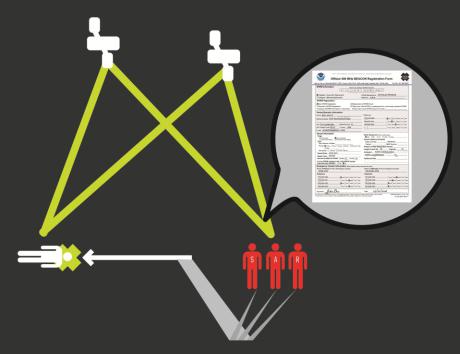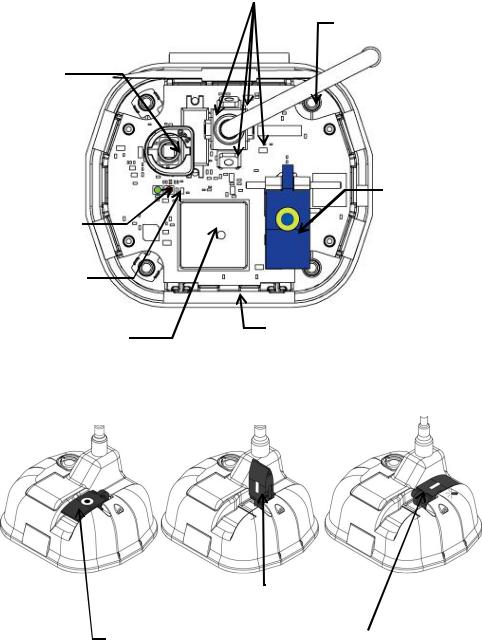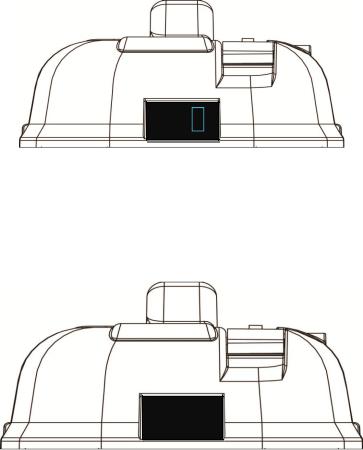ACR Electronics RLB-36 User Manual

PRODUCT SUPPORT MANUAL
GLOBALFIX™ iPRO
406 MHz GPS EPIRB //
Model No.: RLB-36
Product No.: 2846.0, 2848.0
Y1-03-0233 Rev. J
ACR Electronics, Inc. // 5757 Ravenswood Road // Fort Lauderdale // FL // 33312-6645 Tel: +1 (954) 981-3333 // Fax: +1 (954) 983-5087 // www.acrartex.com

 CAUTION: Before proceeding to install, test or use your new ACR Electronics’ product, please read this Product Support Manual in its entirety.
CAUTION: Before proceeding to install, test or use your new ACR Electronics’ product, please read this Product Support Manual in its entirety.
If you have questions regarding the contents of the manual, please contact our Technical Service Department at ACR Electronics, Inc., Telephone +1 (954) 9813333. Please be ready to provide the technician with the page number you wish to discuss. If you have a question that is not covered in the manual, please visit our website and access the Frequently Asked Questions (FAQs) section for further information or call our Technical Service Department. The website address is www.acrartex.com. If in the future you lose this manual, you may access and print a replacement on the ACR website.
NOTE re: Applicable products
This manual supports all configurations of GlobalFix™ iPRO/ RLB-36 beacons. In addition to the part numbers listed on the cover page, other configurations of these products are available, thus you may have purchased a product configuration with a somewhat different part number. As long as the first four digits are the same as one of the two part numbers on the cover, this manual is applicable.
OWNER
VESSEL
RADIO CALL SIGN
MMSI
EPIRB UIN
Y1-03-0233 Rev. J |
1 |

Table of Contents
STEP ONE - REGISTERING YOUR BEACON ___________________________________ 2 STEP TWO - HOW THE BEACON WORKS ____________________________________ 6 STEP THREE - INSTALLING THE BEACON ___________________________________ 16 STEP FOUR - MAINTAINING THE BEACON __________________________________ 21
APPENDIX A - USING AND TESTING THE GPS SYSTEMS ________________________ 27 APPENDIX B - USER INTERFACE: SPECIAL ICONS______________________________ 29 APPENDIX C - USER INTERFACE: DIGITAL DISPLAY DURING OPERATION___________ 30 APPENDIX D - USER INTERFACE: DIGITAL DISPLAY DURING SELF-TEST ____________ 33 APPENDIX E - USER INTERFACE: DIGITAL DISPLAY DURING EXTENDED GPS TEST____ 36 APPENDIX F- USER INTERFACE: LANGUAGE TRANSLATIONS ____________________ 37 APPENDIX G - THE COSPAS-SARSAT SYSTEM ________________________________ 38 APPENDIX H - TECHNICAL SPECIFICATIONS _________________________________ 39 APPENDIX I - WARRANTY, NOTICES _______________________________________ 40
 PLEASE READ ALL WARNINGS, CAUTIONS
PLEASE READ ALL WARNINGS, CAUTIONS
AND NOTES CAREFULLY
Y1-03-0233 Rev. J |
2 |

STEP ONE - REGISTERING YOUR BEACON
1.Why is registration important?
As the owner of this 406 MHz beacon, it is mandatory that you register it with the EPIRB national authority of your country: It is the law. Please note that all 406 MHz beacons are required to have their registration updated every two years by the owner.
Your unique ID code
programmed inside each EPIRB is transmitted to Search and Rescue (SAR). SAR forces use this code to pull up your registration to find out valuable information about who needs help.
 YOUR RESCUE WILL BE DELAYED IF YOUR BEACON ISN’T PROPERLY REGISTERED!
YOUR RESCUE WILL BE DELAYED IF YOUR BEACON ISN’T PROPERLY REGISTERED!
HOW REGISTRATION WORKS:
All 406 MHz beacons transmit a Unique Identifier Number (UIN) when activated. This UIN is programmed into the beacon based on the country in which the beacon is registered, thus authorities are able to determine which country’s database will have your registration information. SAR forces will have information as to who you are as the owner of the beacon, the name and type of vessel that you have, your homeport, and who to contact that might know of your current situation - but only if your beacon has been properly registered. Valuable search and rescue resources are wasted every year responding to false alarms, and registering your beacon helps to resolve false alarms quickly.
Y1-03-0233 Rev. J |
3 |

2.What country should I register in?
Register your beacon with the EPIRB national authority of the country for which the beacon was programmed, typically the country where purchased, regardless of where you do your boating.
The beacon must be reprogrammed if you, as the owner, move or the vessel sails under the flag of a different country than the one for which the beacon was previously programmed. To verify the country for which a beacon is programmed, see the label with the UIN (Unique Identification Number) on the back of the unit. Units that do not have a country specified on the UIN label are programmed for the United States.
3.How do I register?
Registration in the United States
The national authority that accepts registrations in the United States is the National Oceanic and Atmospheric Administration (NOAA).
Here are three ways to register:
1.The fastest and easiest way to register is online at www.beaconregistration.noaa.gov/.
2.Faxing a registration is also acceptable. Fax the registration form to the fax number on the top of the registration form.
NOTE: Do not confuse the registration form with the ACR Electronics warranty card.
3.If online or fax registration is not available, mail the registration form with the pre-addressed, postage paid envelope to:
SARSAT Beacon Registration NOAA
NSOF, E/SPO53
4231 Suitland Road
Suitland, MD 20746
All registration forms will be entered in the 406 MHz beacon registration database within 48 hours of receipt. The information you provide on the registration form is used for rescue purposes only.
A confirmation letter, a copy of the actual registration and a proof-of- registration decal will be mailed to you within two weeks. When you receive these documents, please check the information carefully with the existing label on the unit, and then affix the decal to your beacon in the area marked “BEACON DECAL HERE.” If you do not receive confirmation back from NOAA in the expected timeframe, call toll free (888) 212-7283 for assistance.
Y1-03-0233 Rev. J |
4 |
Registration outside of the United States
In countries other than the United States, 406 MHz beacons are registered with that country’s national authority at the time of purchase.
The sales agent should have assisted you in filling out the forms and sending them to the country’s national authority. Alternatively, many countries allow online registration in the International 406 MHz Beacon Registration Database (IBRD) at www.406registration.com.
To verify that the unit is properly programmed for your country, view the UIN label on the back of the unit. In the event that the beacon is not programmed for your country, the sales agent (if properly equipped) can reprogram the unit for the correct country.
4.Do I need a radio license?
In the United States, you may or may not need to obtain or update a radio station license. Check the FCC’s website at http://wireless.fcc.gov/services/index.htm?job=licensing&id=ship_stations or call toll-free (888) 225-5322 (CALLFCC) for the latest information.
Outside of the United States, contact your local authority for the requirements.
Y1-03-0233 Rev. J |
5 |
STEP TWO - HOW THE BEACON WORKS
1.How your beacon brings help
406 MHz beacons are a type of portable emergency equipment that transmits a distress signal to search and rescue (SAR) organizations. The purpose of these beacons is to aid SAR teams in tracking and locating ships or individuals in jeopardy as rapidly as possible.
The 406 MHz frequency is a worldwide dedicated emergency frequency that is detected by a special system of satellites called the CospasSarsat system. This satellite system was established by, and continues to be supported by, its primary benefactors - the USA, Russia, Canada and France. The Cospas-Sarsat system has saved over 23,500 lives - and counting - since its inception. See Appendix G or the Cospas-Sarsat website for more information about the system at www.cospassarsat.org.
When a 406 MHz beacon is activated, the digital distress message is sent to Cospas-Sarsat satellites and, in turn, the distress message is relayed to SAR. The distress message contains important information about the beacon and its owner. Additional information about the beacon is accessed by SAR from the beacon registration database. At the same time the 406 MHz signal is activated, a 121.5 MHz signal is turned on. The 121.5 MHz signal is used by SAR to home in on the beacon as they approach it.
The 406 MHz signal is detected by multiple satellites and from that information the location of the beacon can be calculated. This data alone is sufficient for SAR to find persons or ships in distress in a reasonable timeframe. However, as a further enhancement, some beacons have a GPS engine onboard. This feature allows the beacon to acquire current location coordinates from an internal GPS receiver or download coordinates from an external GPS receiver. The coordinates are added to the ID of the unit, which is transmitted with the 406 signal. This enables the SAR authorities to locate the beacon to an accuracy of 110 yards (100 m).
Y1-03-0233 Rev. J |
6 |

2.Anatomy of your beacon
NOTE: When unpacking your beacon, it is recommended that you save the original packaging for re-use when shipping the beacon for battery replacement in the future.
// Activation switch with Witness Tab
The activation switch embodies a special, patented method of activating a beacon. Refer to a subsequent section of this manual for how to activate the beacon.
// External GPS interface
The external GPS interface serves as the connection to the ship’s GPS system.
// Internal GPS engine
The internal GPS engine is located where it can most readily get a clear view of the sky.
Y1-03-0233 Rev. J |
7 |

|
Strobes |
|
|
|
Antenna |
Top View |
|
|
|
|
|
|
|
|
GPS
Interface
Activation/Test
Switch
Green
LED
Red
LED
Digital Display
Internal GPS Screen
Receiver
Switch Positions
TEST
Position
ON/TRANSMITTING
OFF/READY Position
Position
Y1-03-0233 Rev. J |
8 |

Category 1 – SeaShelter™3 Bracket
Spring |
HydroFix™ |
Release |
Hydrostatic |
knob |
Release Unit |
|
(HRU) |
GPS
Interface
Cable
Category 2 – LowPro™3 Bracket
Antenna hook
Release
Latch
Ejector spring
Antenna hook
Front cover hook (detent)
Water Sensor
Deactivation Magnet
GPS
Interface
Stowage
Port
Front Cover
Release Tabs
Y1-03-0233 Rev. J |
9 |

3.Digital Display
The digital display in the beacon is used as a secondary visual aid, supporting the green/red LED and the audio tone, which indicate the status of the beacon during testing and during emergency operation.
The messages on the digital display typically appear as one or two words at a time, until the entire message has been displayed.
When the beacon is activated, the display will show the message EPIRB ON. The beacon will begin to send 406 MHz emergency signal bursts, at which time the display provides other messages including 406 SENT, 121.5 ON and GPS coordinates, provided the data was acquired. If GPS data has not been successfully downloaded into the beacon, the digital display will give you tips like “GIVE CLEAR VIEW TO SKY.”
GPS √
In Self-Test, the display illustrates the test result of each step with “√” indicating a pass and “X” indicating a failure. There are a total of five tests, plus a battery check. If all tests pass, SELF-TEST PASS will be displayed at the end of the Self-Test mode. This will be followed by the GPS coordinates horizontally scrolling through the display, provided the beacon has successfully downloaded an external GPS location. See Appendixes B through E for details about display messages.
EPIRB
ON
Language translations of the digital display messages are available from your local Battery Replacement Center (BRC). The messages can be converted to French, Spanish, German and Italian. See Appendix F for a list of messages by language.
Y1-03-0233 Rev. J |
10 |

4.Activating your beacon
 WARNING: This transmitter is authorized for use only during situations of grave and imminent danger. Deliberate misuse may incur a severe penalty.
WARNING: This transmitter is authorized for use only during situations of grave and imminent danger. Deliberate misuse may incur a severe penalty.
Overview
Category I beacons are designed to be automatically deployed and activated in the event of a sinking vessel. The beacon may also be hand held on the deck of vessels, or floated in water and attached to a raft or life vest with the lanyard provided.
Category II beacons are designed to be manually deployed from the bracket.
Two conditions must be met for a Category II beacon to automatically activate:
//It must be out of its bracket
//It must be wet
NOTE: Either condition by itself will not automatically activate the beacon.
Category I and II beacons can always be manually activated in or out of their bracket.
The beacon and bracket are designed to allow the user to perform periodic testing while the beacon is in its bracket.
Y1-03-0233 Rev. J |
11 |

Category I beacons-Automatic deployment and activation
If the vessel sinks, the HydroFix™ HRU frees the beacon from the bracket, allowing it to float to the surface. Built-in sensors detect that the beacon is no longer in its bracket and when continuity is created by water between two of the top cap screws, an activation circuit is completed.
NOTE: Transmission of the 121.5 MHz and 406 MHz signals will not occur until 100 seconds after activation.
HRU releases the rod separating the front and back cover of bracket at a depth between 4-13 feet
Ejector Spring launches EPIRB from the bracket allowing it to float freely to the water surface
Y1-03-0233 Rev. J |
12 |
